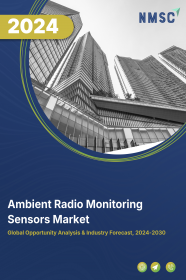
Ambient Radio Monitoring Sensors Market by Product Type (Portable Sensors and Fixed Sensors), by Application (Telecommunications, Military & Defense, Aerospace, Environment Monitoring, Consumer Electronics, and Others) – Global Opportunity Analysis and Industry Forecast 2024-2030
Ambient Radio Monitoring Sensors Market Overview
The Ambient Radio Monitoring Sensors Market size was valued at USD 12.50 billion in 2023 and is predicted to reach USD 27.72 billion by 2030 with a CAGR of 12.1% from 2024-2030. Ambient radio monitoring sensors are sophisticated electronic devices designed to detect and measure radio waves in the surrounding environment. Their primary function is to optimize the utilization of the radio frequency spectrum by detecting and analyzing various radio waves present in the environment, including those from wireless communication, broadcasting, and radar systems.
These sensors play a crucial role in identifying potential interference or congestion within the spectrum, facilitating the efficient allocation of frequencies for different applications. Beyond spectrum management, ambient radio monitoring sensors are instrumental in ensuring the reliability and speed of wireless communication, monitoring environmental conditions, detecting radiation levels, and identifying security risks.
Market Dynamics and Trends
The ambient radio monitoring sensors market is being driven by the growing demand for wireless communication in industries such as telecommunications and transportation as these sensors are essential for monitoring and ensuring the efficient and effective operation of wireless networks and identifying potential issues and improving network performance.
According to the Wireless Infrastructure Association (WIA), the wireless industry experiences annual traffic growth of over 30%. Major carriers respond by investing heavily in network scale and efficiency, deploying spectrum, upgrading to 5G, and investing in Open RAN (O-RAN) for interoperability between vendors' equipment.
Moreover, the rising concerns about the health effects of electromagnetic radiation from devices such as mobile phones and Wi-Fi routers are further driving the need for ambient radio monitoring sensors to measure and monitor various types of radiation and ensure safe exposure levels. According to the World Health Organization (WHO), the electromagnetic fields (EMF) of all frequencies are increasingly prevalent and subject to rising concern and speculation due to their environmental impact.
Furthermore, the proliferation of IoT devices and the development of smart city initiatives require comprehensive monitoring of ambient radio frequencies to ensure efficient wireless communication networks and mitigate interference issues. As per McKinsey, around 127 new devices were connecting to the internet every second, with an anticipated global total of 43 billion connected devices by 2023, nearly tripling the 2018 count.
However, high costs of installation & maintenance along with the potential data privacy & security concerns related to ambient radio monitoring sensors are the major factors restraining the growth of the market. On the contrary, the development of advanced technologies such as 5G networks and Web 4.0 making more advanced and accurate sensors is creating an ample number of opportunities for ambient radio monitoring sensors in the coming years. According to the GSMA Intelligence, it is anticipated that 5G connections will take precedence, constituting more than half (51%) of mobile connections by 2029, and this share is projected to increase to 56% by the decade's end.
Market Segmentations and Scope of the Study
The ambient radio monitoring sensors market is segmented based on product type, application, and region. By product type, the market can be divided into portable and fixed sensors. Based on application, the market can be segmented into telecommunications, military & defense, aerospace, consumer electronics, and others. Regional breakdown and analysis of each of the aforesaid segments include regions comprising North America, Europe, Asia-Pacific, and RoW.
Geographical Analysis
Asia-Pacific dominates the ambient radio monitoring sensors market shareand is expected to continue its dominance during the forecast period. This is attributed to factors such as the growing consumer electronics industry due to the increasing demand for consumer electronics products such as smartphones, tablets, laptops, and smart home devices in the Asia-Pacific region is leading to a surge in the number of wireless communication networks. According to the Semiconductor Industry Association, China is the world’s largest manufacturing hub, producing 36% of the world’s electronics including smartphones, computers, and wearables among others in 2021.
Moreover, the presence of the largest automotive manufacturing industry is further driving the growth of the ambient radio monitoring sensors market as automobile manufacturers use sensors such as Bluetooth, wi-fi, and cellular networks to regulate radio frequencies & ensure the smooth functioning of communication and entertainment systems. According to the China Association of Automobile Manufacturers, China sold a total of 27 million vehicles in 2022 as compared to the 23 million car sales in 2021.
This surge in vehicle manufacturing is leading to an increased demand for ambient radio technology in vehicles, as these sensors play a crucial role in ensuring seamless communication and optimal performance of vehicle systems by monitoring and managing ambient radio frequencies.
On the other hand, North America is expected to show a steady growth in the ambient radio monitoring sensors market. The military & defense industry in North America is driving the growth of the ambient radio monitoring sensors market due to its need for monitoring and managing wireless communication systems used in unmanned aerial vehicles (UAVs), military radios, and satellite communication systems.
According to the US Department of Defense, the U.S. plans to invest USD 1.64 trillion in the military and defense sector in 2022 for the development of highly advanced weapons and equipment including the use of ambient radio monitoring sensors to enhance surveillance, communication, and spectrum management capabilities within the defense forces.
Moreover, the presence of key market players such as Keysight Technologies, Tektronix, and Viavi Solutions plays an important role in the growth of the ambient radio monitoring sensors market. For instance, in November 2022, Keysight Technologies released new automated remote monitoring solutions to improve the quality of service in public and private 5G networks by enabling remote monitoring of performance & identification of issues and providing a comprehensive view of network infrastructure. The solutions are designed to help network operators deliver high-quality 5G services and improve network efficiency.
Competitive Landscape
Various market players operating in the ambient radio monitoring sensors market include Rohde & Schwarz, Keysight Technologies, Anritsu Corporation, Tektronix, Viavi Solutions, Bird Technologies, Kaltman Creations, Aaronia AG, Narda Safety Test Solutions, Safaricom Limited, CareAI, Attune, Wiliot, Airthings, SmartPixels, and others. These market players are adopting various strategies such as collaboration and product launches to remain dominant in the ambient radio monitoring sensors market.
For instance, in January 2024, Wiliot demonstrated the potential of ambient IoT in retail at NRF 2024, showcasing real-time supply chain visibility from warehouse to store to home. This technology offers retailers, manufacturers, and consumers end-to-end product tracking, optimizing operations, and enhancing the shopping experience.
Also, in April 2023, CareAI collaborated with Google Cloud to expand its ambient monitoring solution to more healthcare systems. The ambient monitoring solution uses artificial intelligence and machine learning to passively monitor patients in hospitals and detect any changes in their conditions and can alert clinicians in real-time, enabling them to provide timely care to patients.
Moreover, in March 2023, Attune launched a new sensor-based platform called "AirBench" for monitoring outdoor air quality that uses a network of sensors to provide real-time data on air quality in cities and other outdoor areas. Through this launch, the company aims to provide data about air pollution levels and to identify areas where improvements are needed for the government and the public.
Furthermore, in January 2023, Wiliot launched a new kit that enables users to experiment with ambient IoT technology and create their applications using Wiliot's "Ambient Power" Bluetooth Low Energy (BLE) chip and software, designed to be powered by ambient energy. The kit is aimed at developers, designers, and engineers who are interested in exploring the potential of ambient IoT technology.
Key Benefits
-
The report provides quantitative analysis and estimations of the ambient radio monitoring sensors market from 2024 to 2030, which assists in identifying the prevailing market opportunities.
-
The study comprises a deep dive analysis of the ambient radio monitoring sensors market including the current and future trends to depict prevalent investment pockets in the market.
-
Information related to key drivers, restraints, and opportunities and their impact on the ambient radio monitoring sensors market is provided in the report.
-
Competitive analysis of the players, along with their market share is provided in the report.
-
SWOT analysis and Porters Five Forces model is elaborated in the study.
-
Value chain analysis in the market study provides a clear picture of roles of stakeholders.
Ambient Radio Monitoring Sensors Market Key MarketSegments
By Product Type
-
Portable Sensors
-
Fixed Sensors
By Application
-
Telecommunications
-
Military & Defense
-
Aerospace
-
Environment Monitoring
-
Consumer Electronics
-
Others
By Region
-
North America
-
The U.S.
-
Canada
-
Mexico
-
-
Europe
-
The UK
-
Germany
-
France
-
Italy
-
Spain
-
Denmark
-
Netherlands
-
Finland
-
Sweden
-
Norway
-
Russia
-
Rest of Europe
-
-
Asia-Pacific
-
China
-
Japan
-
India
-
South Korea
-
Australia
-
Indonesia
-
Singapore
-
Taiwan
-
Thailand
-
Rest of Asia-Pacific
-
-
RoW
-
Latin America
-
Middle East
-
Africa
-
Key Players
-
Rohde & Schwarz
-
Keysight Technologies
-
Anritsu Corporation
-
Tektronix
-
Viavi Solutions
-
Bird Technologies
-
Kaltman Creations
-
Aaronia AG
-
Narda Safety Test Solutions
-
Safaricom Limited
-
CareAI
-
Attune
-
Wiliot
-
Airthings
-
SmartPixels
REPORT SCOPE AND SEGMENTATION:
|
Parameters |
Details |
|
Market Size in 2023 |
USD 12.50 Billion |
|
Revenue Forecast in 2030 |
USD 27.72 Billion |
|
Growth Rate |
CAGR of 12.1% from 2024 to 2030 |
|
Analysis Period |
2023–2030 |
|
Base Year Considered |
2023 |
|
Forecast Period |
2024–2030 |
|
Market Size Estimation |
Billion (USD) |
|
Growth Factors |
|
|
Countries Covered |
28 |
|
Companies Profiled |
15 |
|
Market Share |
Available for 10 companies |
|
Customization Scope |
Free customization (equivalent up to 80 working hours of analysts) after purchase. Addition or alteration to country, regional, and segment scope. |
|
Pricing and Purchase Options |
Avail customized purchase options to meet your exact research needs. |




















 Speak to Our Analyst
Speak to Our Analyst
























